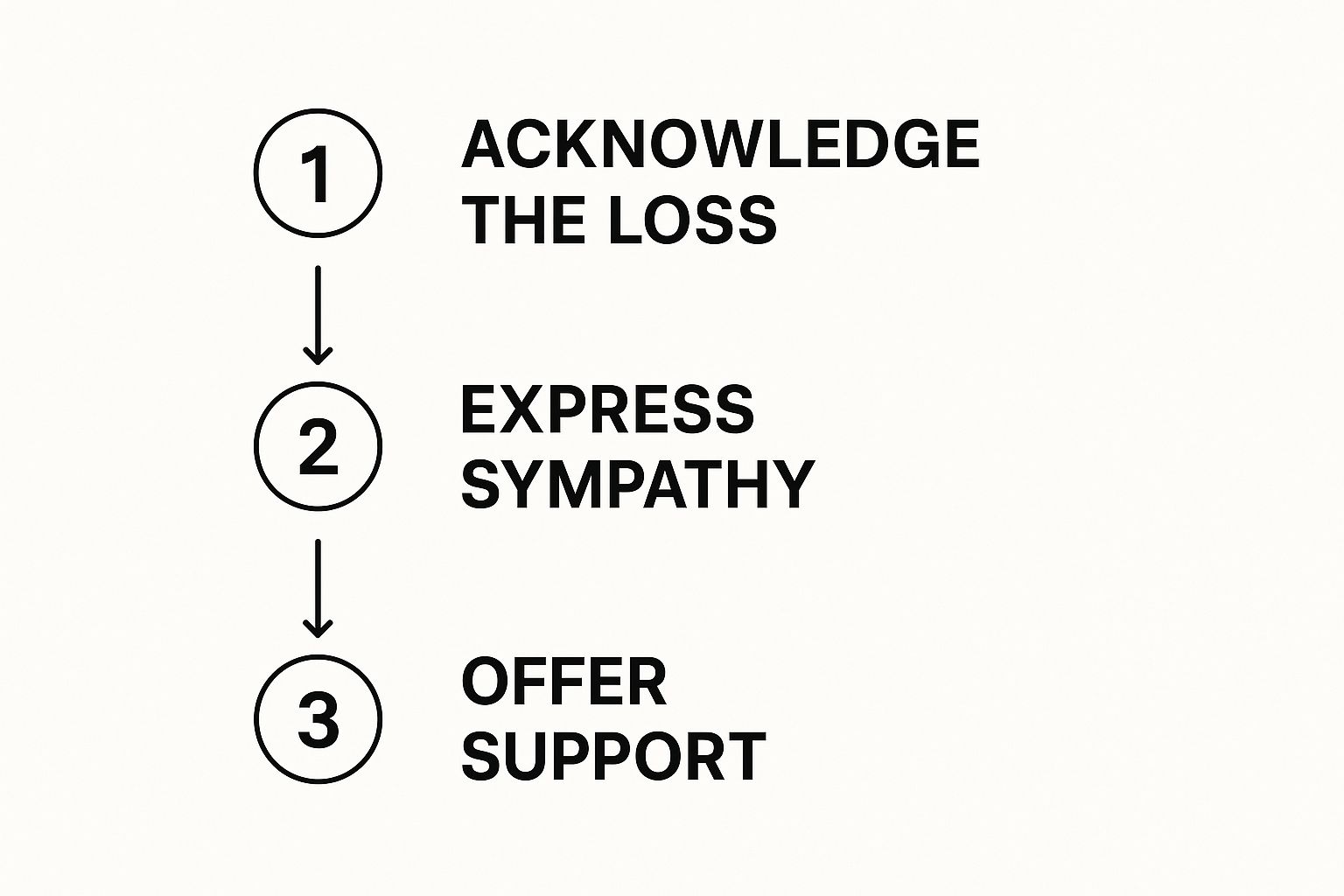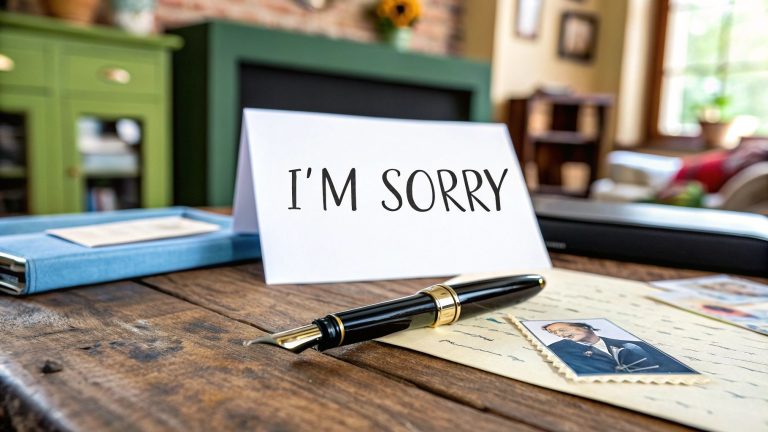It’s a feeling we all know: that moment you stare at a blank sympathy card, pen in hand, completely frozen. You want so badly to offer comfort, but you're terrified of saying the wrong thing.
The truth is, learning how to write a condolence letter isn't about finding the perfect, poetic phrase. It’s about three simple things: acknowledging the loss, sharing a warm memory, and offering real support. Sincerity always wins over perfection.
The Gentle Art of Expressing Sympathy
When someone is deep in grief, silence from the people who care about them can feel like a heavy blanket of isolation. Your first and most important job is simply to push past that hesitation and write something.
A condolence letter becomes a tangible piece of comfort. It's something the grieving person can hold, read, and re-read, reminding them that they aren’t alone and that the person they lost mattered to others, too. You’re not trying to erase their pain—that’s impossible. You’re simply showing up to share in their grief and honor a life well-lived.

This simple act forges a powerful connection. Your heartfelt message validates their feelings and confirms that their loved one left a mark on the world. If you want to make it even more personal, using custom greeting cards can add a beautiful, unique touch.
Sincerity Over Perfection
So many of us put off writing because we’re stuck searching for just the right words. But honestly, the most comforting and meaningful messages are often the simplest ones. Authenticity will always mean more than flowery, elaborate language.
Focus on these core elements:
- Honesty: Start by simply saying you are sad to hear about their loss.
- A Personal Touch: Sharing a specific, happy memory of the person is one of the kindest things you can do.
- Empathy: Show them you're thinking of them and that you care about how they're doing.
A heartfelt condolence letter is more than just an obligation; it is a profound gesture of compassion that can provide lasting comfort during one of life’s most challenging times.
In the end, the simple act of reaching out is what truly counts. The principles of clear, empathetic writing are valuable in so many areas of life. If you ever need help with other types of correspondence, you can find great resources when you need to write a personal letter for happier occasions, too.
Crafting a Sincere and Heartfelt Message
Figuring out what to write in a condolence letter can feel paralyzing. But it often comes down to a simple, thoughtful structure. Think of it less as a rigid formula and more as a way to organize your thoughts so your message brings comfort, not confusion. Your goal is to acknowledge the loss, share something meaningful, and offer real support.
Start by Acknowledging the Loss
The beginning of your letter should be gentle yet direct. Simply state why you're writing and express your sorrow. You don't need to find some profound, poetic phrase.
Something as simple as, “I was so heartbroken to hear about [Name]'s passing,” or, “I was so sorry to learn of your loss,” works perfectly. It sets a compassionate and sincere tone right from the start. If you're struggling with the opening line, looking at different letter salutations can sometimes help get the words flowing.

As you can see, the path from acknowledging the pain to sharing a personal memory is what makes a message truly connect.
Share a Specific, Cherished Memory
This is the heart of your letter. The middle section is your chance to give a truly personal gift: a fond memory of the person they've lost. Vague compliments are nice, but a specific story is so much more powerful.
Think of a time they made you laugh or a moment their kindness really stood out. A short, positive anecdote can bring a small flicker of light during a very dark time.
For instance, you might write:
- “I’ll always remember that time [Name] stayed late to help me finish that impossible project. His patience and good humor made all the difference.”
- “I was just smiling to myself thinking about that summer barbecue when she told that hilarious story about her first car. Her laugh was absolutely infectious.”
By sharing a memory, you’re showing the person that their loved one made a real impact and won't be forgotten.
A specific memory transforms a sympathy card from a simple acknowledgment of death into a heartfelt celebration of a life.
A well-structured letter guides the reader through these gentle stages of remembrance and support. The table below breaks down these core components.
Key Components of a Heartfelt Condolence Letter
| Section | Purpose | Example Phrases |
|---|---|---|
| Opening | Acknowledge the loss and express sympathy. | "I was so saddened to hear about…" "My heart goes out to you and your family." |
| Body | Share a positive, specific memory. | "I'll never forget the time he…" "One of my favorite memories of her is…" |
| Closing | Offer specific, tangible support. | "I'd love to drop off dinner next week." "I'll call to check in on Friday." |
These pieces work together to create a message that feels whole and genuinely caring.
End with a Genuine Offer of Support
How you close the letter is just as important as how you open it. The key is to offer concrete, specific help. A vague, "Let me know if you need anything," is well-intentioned, but it puts the burden on the grieving person to figure out what they need and then ask for it. Most people won't.
Instead, offer something tangible.
- Practical Help: "I'm making a big pot of soup this weekend and would love to bring some by for your family. Would Saturday or Sunday be better?"
- Your Time: "I'm free on Tuesday mornings if you need someone to run errands or just sit with you for a bit."
- Companionship: "I'll give you a call next week just to check in. No pressure to talk if you don't feel up to it."
This approach makes it incredibly easy for them to say "yes" to your help. And if you find yourself wanting to express your thoughts more clearly in writing, there are always great resources on how to improve your writing skills. By focusing on these three parts—acknowledging, sharing, and supporting—your letter will be a powerful source of comfort.
Choosing Words That Heal Instead of Hurt
When you sit down to write a condolence letter, the words you choose matter more than you can imagine. Your intentions are good, of course, but it’s surprisingly easy to fall back on common phrases that can inadvertently cause more pain than comfort.
We’ve all heard them. Expressions like "They're in a better place" or "Everything happens for a reason" can feel like a dismissal of the very real, very raw pain someone is feeling right now. And telling someone "I know how you feel" is almost always a misstep—grief is just too personal for that.

Gentle Alternatives to Common Pitfalls
Instead of reaching for platitudes, the goal is to offer simple, honest words that acknowledge the person's feelings without making assumptions. You're there to offer support, not to provide answers or solutions.
Here are a few common phrases to sidestep and what you could say instead:
-
Instead of: "I know how you feel."
-
Try: "I can't imagine what you must be feeling, but I am here for you." This acknowledges their unique pain.
-
Instead of: "They're in a better place."
-
Try: "I am so incredibly sorry for your loss. [Name] was such a wonderful person." This focuses on the person and the loss, not a philosophical debate.
-
Instead of: "Let me know if you need anything."
-
Try: "I'm thinking of you and will call to check in next week." This offers concrete action and takes the burden off them to ask for help.
This simple shift makes all the difference. It's about being present with their pain, not trying to fix it. This approach is central to good letter writing etiquette—choosing words that support, not prescribe.
Phrases That Offer True Comfort
So, what actually helps? Focus on three things: expressing genuine sorrow, sharing a fond memory, and offering specific support. These messages connect because they come from a real place.
The most comforting condolence messages are not about finding the perfect words, but about showing up with a compassionate heart and the courage to be present in someone else’s pain.
Research actually confirms this. A study analyzing sympathy cards found that the most meaningful messages were those that respected the uniqueness of the grieving process. The study also pointed out a common social habit of making insensitive remarks, like rushing the healing process or leaning on religious clichés.
At the end of the day, a few heartfelt sentences will always be more powerful than a paragraph full of empty phrases. Your sincere presence on the page is the greatest gift you can offer.
Why Your Letter Matters More Than You Think
In a world filled with texts, DMs, and quick emails, it's easy to think a formal letter is outdated. But when someone is grieving, taking the time to write and send a physical condolence letter is one of the most powerful things you can do.
It’s a tangible gesture that cuts through the digital noise. It shows you genuinely care. You might feel a little stuck, worried you won't say the right thing, but your effort alone speaks volumes.
When someone receives a personal letter, it confirms that their loved one mattered to other people, that their life was seen and will be remembered. For someone lost in the fog of grief, each letter is a small beacon of light they can hold onto and reread whenever they need it. It’s a quiet reminder that they aren't as alone as they feel.
It's Not Just for Them—It's for You, Too
Believe it or not, the act of writing doesn’t just help the person receiving the letter. It also gives you, the writer, a quiet moment to process your own feelings about the loss.
Sitting down to gather your thoughts can be a surprisingly reflective process. It helps you connect with your own sense of empathy and strengthens your bond with the person you’re writing to.
Sometimes, knowing that it’s a mutually beneficial act is all the motivation you need to push past the hesitation. Sharing in someone's sorrow builds a deeper connection and, as research into positive psychology has shown, writing about difficult emotions can actually lead to positive outcomes. You can learn more about the psychology of writing condolence letters.
Your letter is more than just words on a page; it’s a physical embodiment of care, a lasting testament that a life was cherished and a loss is deeply felt.
So when you put pen to paper, remember you’re not just sending a note. You’re offering a real, human connection at a time when it’s needed most.
Writing a Condolence Letter for a Colleague
Navigating grief in a professional setting is tough. When a colleague, client, or their family is going through a loss, it's important to offer comfort while still respecting workplace boundaries. The goal is to be sincere and supportive without being intrusive.

How well you knew the person really shapes what you should write. If you were close to a coworker, sharing a warm, specific memory can mean the world. Something like, “I’ll always remember how Sarah mentored me during the Johnson project. Her guidance made all the difference,” feels personal and genuine.
On the other hand, if you’re writing to a client or a colleague you didn’t know well, a more reserved and formal tone is better. In that case, focus on a simple expression of sympathy from yourself or the team.
Keeping Your Tone Professional and Supportive
The trick is to find that sweet spot between being supportive and getting too personal. You want to respect their privacy while letting them know you care.
Here are a few pointers that I've found helpful:
- Acknowledge their loss directly. A simple, heartfelt opening like, “I was so saddened to hear about your loss,” is always a good place to start.
- Offer specific, practical help. Vague offers can feel empty. Instead, try something concrete: “Our team is handling all your urgent tasks, so please don’t feel the need to check in. Focus on your family.”
- Show team-wide support. If it makes sense, signing the card or letter from the entire department can be a powerful way to show collective support and care.
This isn’t just good etiquette; it’s becoming a recognized part of compassionate care in many professional fields. For instance, a project at Memorial Sloan Kettering Cancer Center actually trained staff on writing condolence cards as a key part of palliative care. You can discover more about this initiative on PMC.
The most meaningful message you can send a colleague is one that reassures them that their work is handled and their contributions are valued. This gives them the mental space to grieve without added stress.
It’s also a good idea to stick to standard business letter practices. If you need a quick refresher, our guide on how to format a letter can help.
A Few Common Questions About Writing Condolence Letters
Trying to get the details right when writing a condolence letter can bring up some tricky questions. You obviously want to do the right thing, but the "rules" aren't always crystal clear. Let's walk through some of the things people often ask.
Is It Okay to Just Send an Email or a Text?
We live in a world of instant communication, so firing off a quick text or email feels like a natural first instinct. And that's perfectly fine for immediate support—it's a good way to let someone know you're thinking of them the moment you hear the news.
But a digital message shouldn't be the final word. A physical, handwritten letter just hits differently. Grief counselors often talk about how tangible letters become keepsakes, something people can hold onto and read again when they need comfort. Your text says, "I'm here for you right now." The follow-up letter says, "I'm still here for you."
What if I Didn’t Know the Person Who Passed Away?
This comes up all the time, especially when a coworker loses a parent or a friend loses a spouse you've never met. The key here is not to pretend. Don't try to invent a connection or speak about someone you didn't know.
Instead, shift your focus entirely to supporting the person you do know. Your letter is for them.
Keep it simple and direct your compassion straight to your friend or colleague. Something like this works beautifully:
"I was so heartbroken to hear about the loss of your father. I can only imagine what you and your family are going through, and I want you to know I'm thinking of you."
Your job is to comfort the living. A sincere, honest message focused on them will always be the right approach.
Is There a Point When It's "Too Late" to Send a Card?
Short answer: No. It is never too late.
Ideally, you'd send a card within the first couple of weeks, but a late card is infinitely better than no card at all. Grief doesn't stick to a timeline. Sometimes, a card that arrives a month or two later is a welcome, wonderful reminder that their loved one hasn't been forgotten.
In fact, your note might land on their doorstep long after the initial wave of support has subsided, making your words feel even more powerful. Please don't let the fear of being "too late" keep you from reaching out.

